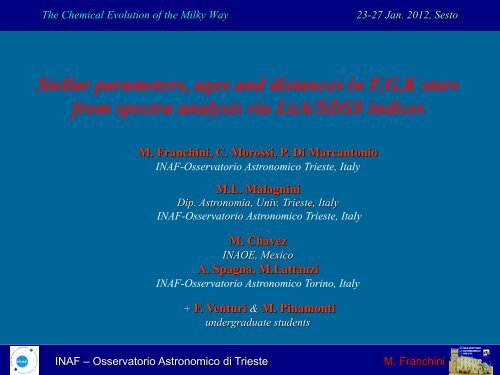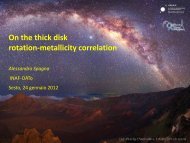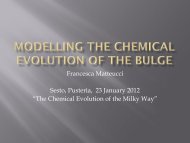Stelle ed evoluzione chimica
Stelle ed evoluzione chimica
Stelle ed evoluzione chimica
Create successful ePaper yourself
Turn your PDF publications into a flip-book with our unique Google optimized e-Paper software.
The Chemical Evolution of the Milky Way 23-27 Jan. 2012, Sesto<br />
Stellar parameters, ages and distances in F,G,K stars<br />
from spectra analysis via Lick/SDSS indices<br />
M. Franchini, C. Morossi, P. Di Marcantonio<br />
INAF-Osservatorio Astronomico Trieste, Italy<br />
M.L. Malagnini<br />
Dip. Astronomia, Univ. Trieste, Italy<br />
INAF-Osservatorio Astronomico Trieste, Italy<br />
M. Chavez<br />
INAOE, Mexico<br />
A. Spagna, M.Lattanzi<br />
INAF-Osservatorio Astronomico Torino, Italy<br />
+ F. Venturi & M. Pinamonti<br />
undergraduate students<br />
INAF – Osservatorio Astronomico di Trieste M. Franchini
Main Goals<br />
To study the chemo-dynamical properties of the<br />
different groups of stars of our Galaxy as trac<strong>ed</strong> by<br />
interm<strong>ed</strong>iate and late type stars (F,G,K)<br />
To contribute in understanding the role of different<br />
sources of chemical enrichment in various epochs of<br />
the Galaxy lifetime<br />
INAF – Osservatorio Astronomico di Trieste M. Franchini
Observational databases<br />
Atmospheric parameters T eff, logg, [Fe/H]<br />
Chemical composition , [Mg/Fe], [Ca/Fe]<br />
Radial velocities<br />
Distances<br />
Proper motions<br />
Orbits<br />
Age<br />
Ingr<strong>ed</strong>ients<br />
INAF – Osservatorio Astronomico di Trieste M. Franchini
•High Resolution<br />
Point<strong>ed</strong> observations<br />
Observational databases<br />
Huge amount of information<br />
but<br />
Time consuming and limit<strong>ed</strong> number of objects<br />
•M<strong>ed</strong>ium/Low Resolution (e.g., SDSS, SEGUE, SEGUE-2, LAMOST)<br />
Extend<strong>ed</strong> spatial coverage<br />
Large and homogeneous number of objects<br />
but<br />
low/m<strong>ed</strong>ium S/N and loss of information due to spectral broadening<br />
INAF – Osservatorio Astronomico di Trieste M. Franchini
Atmospheric parameters T eff, logg, [Fe/H]<br />
• High Resolution<br />
Accurate estimates<br />
but<br />
Not homogenous estimates and limit<strong>ed</strong> number of objects<br />
• M<strong>ed</strong>ium/Low Resolution surveys<br />
Homogeneous estimates for large number of objects<br />
but<br />
Less accurate estimates<br />
INAF – Osservatorio Astronomico di Trieste M. Franchini
Atmospheric parameters T eff, logg, [Fe/H]<br />
• SPSS (Segue Stellar Parameter Pipeline):<br />
Provides (table sppParams) individual estimates of T eff, logg, [Fe/H]<br />
T eff 11 estimates<br />
Log g 10 estimates<br />
[Fe/H] 12 estimates<br />
but (Franchini et al. ApJ 2010, 719, 240)<br />
Systematic differences are present among the 11 T eff estimates<br />
Not always T eff, log g, [Fe/H] are simultaneously deriv<strong>ed</strong><br />
Mean values lack of internal consistency<br />
Systematic overestimates of T eff values for giants<br />
therefore …..<br />
Deriv<strong>ed</strong> with different techniques<br />
INAF – Osservatorio Astronomico di Trieste M. Franchini
Atmospheric parameters T eff, logg, [Fe/H]<br />
•From Lick/SDSS library (Franchini et al. ApJ 2011, 730, 117)<br />
We derive atmospheric parameters on the basis of the Lick/SDSS synthetic<br />
library (Franchini et al. ApJ 2010, 719, 240) by comparing synthetic and<br />
observ<strong>ed</strong> spectral indices<br />
Indices are negligibly affect<strong>ed</strong> by errors in flux calibration and by<br />
r<strong>ed</strong>dening<br />
Narrow-band indices allow the measurement of the intensity of features<br />
of different chemical species separately<br />
Indices are characteriz<strong>ed</strong> by higher S/N than the original spectra<br />
Homogeneous and self-consistent atmospheric parameter estimates<br />
INAF – Osservatorio Astronomico di Trieste M. Franchini
Lick/SDSS library<br />
Comput<strong>ed</strong> starting from synthetic spectra degrad<strong>ed</strong> at R=1800 (like SDSS)<br />
Two grid of HiRes synthetic spectra:<br />
Solar Scal<strong>ed</strong> [ /Fe] = +0.0 (SSA) and -enhanc<strong>ed</strong> [ /Fe] = +0.4 (NSSA)<br />
starting from Kurucz atmosphere models (ATLAS9) comput<strong>ed</strong> with solar and enhanc<strong>ed</strong><br />
ODF’s by Castelli (2003)<br />
using SPECTRUM V.2.75 (Gray and Corbally 1994)<br />
There is full consistency between synthetic spectra and the ODF<br />
of the atmosphere models<br />
Teff : 3500-7000 K (250 K step)<br />
log g: 0.5- 5.0 dex (0.5 dex step)<br />
[Fe/H]=-2.5,-2.0,-1.5,-1.0,-0.5,0.0,+0.2,+0.5 (SSA)<br />
[Fe/H]=-2.5,-2.0,-1.5,-1.0,-0.5,0.0,+0.2,+0.5 (NSSA)<br />
INAF – Osservatorio Astronomico di Trieste M. Franchini
Lick/SDSS Spectral Indices<br />
Name Feature Bandpass Pseudocontinua Units IDS Error Measures<br />
------------------------------------------------------------------------------------<br />
01 Cahk 3900.000-4000.000 * 3837.000-3877.000 Ang 0.64 CaII<br />
4040.000-4080.000<br />
02 CN 1 4143.375-4178.375 4081.375-4118.875 mag 0.021 CN, FeI<br />
4245.375-4285.375<br />
03 CN 2 4143.375-4178.375 4085.125-4097.625 mag 0.023 CN, FeI<br />
4245.375-4285.375<br />
04 Ca4227 4223.500-4236.000 4212.250-4221.000 Ang 0.27 CaI, FeI, FeII<br />
4242.250-4252.250<br />
05 G4300 4282.625-4317.625 4267.625-4283.875 Ang 0.39 CH, FeI<br />
4320.125-4336.375<br />
06 Fe4383 4370.375-4421.625 4360.375-4371.625 Ang 0.53 FeI, TiII<br />
4444.125-4456.625<br />
07 Ca4455 4453.375-4475.875 4447.125-4455.875 Ang 0.25 CaI, FeI, NiI,<br />
4478.375-4493.375 TiII, MnI, VI<br />
08 Fe4531 4515.500-4560.500 4505.500-4515.500 Ang 0.42 FeI, TiI, FeII,<br />
4561.750-4580.500 TiII<br />
9 H beta 4847.875-4876.625 4827.875-4847.875 Ang 0.22 H, FeI<br />
4876.625-4891.625<br />
10 Fe5015 4977.750-5054.000 4946.500-4977.750 Ang 0.46 FeI, NiI, TiI<br />
5054.000-5065.250<br />
11 Mg1 5069.125-5134.125 4895.125-4957.625 mag 0.007 MgH, FeI, NiI<br />
5301.125-5366.125<br />
12 Mg2 5154.125-5196.625 4895.125-4957.625 mag 0.008 MgH, MgI, FeI<br />
5301.125-5366.125<br />
13 Mgb 5160.125-5192.625 5142.625-5161.375 Ang 0.23 MgI<br />
5191.375-5206.375<br />
14 Fe5270 5245.650-5285.650 5233.150-5248.150 Ang 0.28 FeI, CaI<br />
5285.650-5318.150<br />
15 Fe5335 5312.125-5352.125 5304.625-5315.875 Ang 0.26 FeI<br />
5353.375-5363.375<br />
16 Fe5406 5387.500-5415.000 5376.250-5387.500 Ang 0.20 FeI, CrI<br />
5415.000-5425.000<br />
17 Fe5709 5698.375-5722.125 5674.625-5698.375 Ang 0.18 FeI, NiI, MgI,<br />
5724.625-5738.375 CrI, VI<br />
18 Fe5782 5778.375-5798.375 5767.125-5777.125 Ang 0.20 FeI, CrI, CuI,<br />
5799.625-5813.375 MgI<br />
19 Na D 5878.625-5911.125 5862.375-5877.375 Ang 0.24 NaI<br />
5923.875-5949.875<br />
* 3931.5-3935.5, 3965.5-3970.5 exclud<strong>ed</strong><br />
[α/Fe]<br />
sensitive group (r<strong>ed</strong>)<br />
interm<strong>ed</strong>iate group<br />
(green)<br />
quasi-indipendent<br />
group (blue).<br />
Lick-like<br />
Indices<br />
(Worthey et al. 1994)<br />
but<br />
R=1800<br />
INAF – Osservatorio Astronomico di Trieste M. Franchini
Lick/SDSS library<br />
The reliabilty of the synthetic Lick/SDSS indices in reproducing the<br />
behaviours of observational ones with T eff, logg, [Fe/H], has been<br />
test<strong>ed</strong> by using stars and stellar parameters from:<br />
ELODIES, INDO-US, MILES (EIM) empirical libraries<br />
541 dwarfs (log g=4.5±0.5) and 391 giants. (log g=2.5±0.5)<br />
INAF – Osservatorio Astronomico di Trieste M. Franchini
Hß<br />
dwarfs<br />
θ<br />
Lick/SDSS library<br />
Hß<br />
giants<br />
INAF – Osservatorio Astronomico di Trieste M. Franchini<br />
θ
Lick/SDSS library<br />
Well reproduc<strong>ed</strong><br />
INAF – Osservatorio Astronomico di Trieste M. Franchini
T Fit, logg Fit, [Fe/H] Fit, Fit<br />
Best-Fit parameters values (T Fit, logg Fit, [Fe/H Fit, Fit) for each<br />
star are deriv<strong>ed</strong> using a χ 2 method to minimize the differences<br />
between observational and synthetic Lick/SDSS indices<br />
1. Bas<strong>ed</strong> on MINUIT minimization package<br />
2. Internal uncertainties in the deriv<strong>ed</strong> parameter estimates were evaluat<strong>ed</strong> via a<br />
MonteCarlo technique<br />
3. Reliability of the results was check<strong>ed</strong> by applying the fitting proc<strong>ed</strong>ure to a test<br />
set of the 333 “bona fide” F,G,K (EIM) stars previously select<strong>ed</strong> with very<br />
reliable atmospheric parameters.<br />
4. Systematic difference (-0.1 dex) between Fit and [Mg/Fe] (Borkova and<br />
Marsakov, 2005) values which can be explain<strong>ed</strong> recalling that Fit<br />
estimates the average enhancement of α-elements<br />
INAF – Osservatorio Astronomico di Trieste M. Franchini
Results for the EIM test sample<br />
T Fit, logg Fit, [Fe/H] Fit, Fit<br />
INAF – Osservatorio Astronomico di Trieste M. Franchini
T Fit, logg Fit, [Fe/H] Fit, Fit<br />
INAF – Osservatorio Astronomico di Trieste M. Franchini
Results for the<br />
SDSS-DR7 sample<br />
4381 stars<br />
Fill<strong>ed</strong> histogram<br />
1880 stars with<br />
S/N≥30<br />
INAF – Osservatorio Astronomico di Trieste M. Franchini
CaHK<br />
Mgb<br />
Chemical composition [Ca/Fe], [Mg/Fe]<br />
•The deriv<strong>ed</strong> Fit values cannot be directly associat<strong>ed</strong> with the<br />
enhancement of any individual α-elements<br />
•We take advantage of the strong sensitivity of some Lick/SDSS indices<br />
mainly to [Ca/Fe] or [Mg/Fe]<br />
___ SSA<br />
___ NSSA<br />
Θ=5040/T eff<br />
INAF – Osservatorio Astronomico di Trieste M. Franchini
Chemical composition [Ca/Fe], [Mg/Fe]<br />
For more than 4000 F,G,K stars (sub-set of SDSS-DR7 spectra) the<br />
abundance ratios [Mg/Fe], [Ca/Fe] were deriv<strong>ed</strong> by comparing synthetic<br />
and observational CaHK and Mg2 Lick/SDSS indices:<br />
1. The two strongest Ca and Mg features in the SDSS wavelength range<br />
2. Two pairs ( 0.0 CaHK, + 0.4 CaHK) & ( 0.0 Mg2, + 0.4 Mg2) at T Fit, logg Fit, [Fe/H] Fit<br />
3. We assume a linear dependence of each index on element abundance and we derive<br />
for each star estimates of [Ca/Fe] and [Mg/Fe] by linear interpolating the<br />
synthetic pairs at the corresponding CaHK and Mg2 observational values<br />
INAF – Osservatorio Astronomico di Trieste M. Franchini
Chemical composition [Ca/Fe], [Mg/Fe]<br />
INAF – Osservatorio Astronomico di Trieste M. Franchini
To investigate the [Mg/Fe] and [Ca/Fe] scatter<br />
We ne<strong>ed</strong> to separate stars belonging to different Galactic component<br />
Different possibilities --- stars with similar:<br />
• Kinematics<br />
• Age<br />
• birth place / environment<br />
• Orbital parameters<br />
We ne<strong>ed</strong>:<br />
• distances<br />
• Radial velocities<br />
• Proper motions<br />
INAF – Osservatorio Astronomico di Trieste M. Franchini
Awaiting for GAIA<br />
Simultaneous Bayesian estimates of spectroscopic<br />
distances and ages from isochrones:<br />
We compare stellar position in (logT eff , log g) plane with isochrones<br />
(Girardi 2004) by using deriv<strong>ed</strong> Fit to convert measur<strong>ed</strong> [Fe/H] Fit<br />
into [M/H] Fit (Degl’ Innocenti et al. 2005)<br />
Bayesian technique:<br />
prob ( Yo|<br />
X )<br />
prob ( X | Yo)<br />
prob ( Yo )<br />
<br />
prob ( Yo | X ) exp<br />
prob (X )<br />
prob ( X<br />
([ M / H]<br />
)<br />
2<br />
2<br />
fit [<br />
M / H])<br />
(log gfit<br />
log g)<br />
(log Tfit<br />
log T<br />
2<br />
2<br />
Fe<br />
X physical parameters to be determin<strong>ed</strong> (i.e. age, M V)<br />
Yo the observational quantities (i.e. T eff, log g, [M/H]).<br />
By integrating over mass and metallicity in fix<strong>ed</strong> intervals of age and M v we<br />
obtain a bi-dimensional posterior probability P(τ,M v)<br />
2<br />
2<br />
g<br />
2<br />
2<br />
T<br />
INAF – Osservatorio Astronomico di Trieste M. Franchini<br />
exp<br />
Prior probability (e.g. IMF, age, Z, …)<br />
exp<br />
)<br />
2
Examples of bi-dimensional posterior probability P(τ,M v)<br />
INAF – Osservatorio Astronomico di Trieste M. Franchini
Examples of bi-dimensional posterior probability P(τ,M v)<br />
WARNING. sometimes the τ and M V corresponding to the peak of P(τ,M V) are different from<br />
those of the maximum of the 1-D P(τ) and of the maximum of the 1-D P(M V), respectively<br />
INAF – Osservatorio Astronomico di Trieste M. Franchini
Other examples and reliability tests<br />
• from<br />
(T eff,M v,[M/H])<br />
Blue box is ±2<br />
• from<br />
(T eff,logg,[M/H])<br />
Contour levels:<br />
0.8, 0.6, 0.4, 0.2<br />
INAF – Osservatorio Astronomico di Trieste M. Franchini
Some examples and reliability tests<br />
EIM stars<br />
with parallactic<br />
distances<br />
INAF – Osservatorio Astronomico di Trieste M. Franchini
Some examples and reliability tests<br />
Check: Relative distribution of deriv<strong>ed</strong> ages for<br />
Hyades MS stars (peak 0.7 Gyr; = 0.6± 0.12 Gyr)<br />
INAF – Osservatorio Astronomico di Trieste M. Franchini
Orbits<br />
Back-integrating the equation of motion using:<br />
A Galactic Potential<br />
A model must be assum<strong>ed</strong>:<br />
e.g. Johnston 1996, ApJ 465, 278<br />
Radial velocity<br />
Via cross-correlation with synthetic spectra templates<br />
proper motions<br />
From literature (SDSS GSC-II Catalogue)<br />
distances<br />
Bayesian determination<br />
INAF – Osservatorio Astronomico di Trieste M. Franchini
Some examples<br />
For a sample of SN stars<br />
taken from Venn et al.<br />
2004, AJ 128,1177<br />
X current position of the Sun<br />
∆ current position of the star<br />
INAF – Osservatorio Astronomico di Trieste M. Franchini
Some examples<br />
For a sample of SN stars<br />
taken from Venn et al.<br />
2004, AJ 128,1177<br />
X current position of the Sun<br />
∆ current position of the star<br />
INAF – Osservatorio Astronomico di Trieste M. Franchini
An example of selection of groups of<br />
stars with similar orbits<br />
[El/H] from literature<br />
Group1 Box<br />
Group2 Box<br />
Rocket<br />
Group3 Box<br />
Rocket<br />
Caotic<br />
Tube<br />
Selection<br />
Orbit Z max<br />
Results<br />
<br />
INAF – Osservatorio Astronomico di Trieste M. Franchini<br />
kpc<br />
kpc<br />
Group1 0.08 0.08<br />
<br />
219<br />
Group2 1.12 0.42 180<br />
Group3 6.88 0.83 -4<br />
R min<br />
kpc<br />
< 0.15 >5.5<br />
0.7-1.5<br />
> 3<br />
2-5<br />
km/s
An example of selection of groups of<br />
stars with similar orbits<br />
Group1 Box<br />
Group2 Box<br />
Rocket<br />
Group3 Box<br />
Rocket<br />
Caotic<br />
Tube<br />
Selection<br />
Orbit Z max<br />
Results<br />
<br />
INAF – Osservatorio Astronomico di Trieste M. Franchini<br />
kpc<br />
kpc<br />
Group1 0.08 0.08<br />
<br />
219<br />
Group2 1.12 0.42 180<br />
Group3 6.88 0.83 -4<br />
R min<br />
kpc<br />
< 0.15 >5.5<br />
0.7-1.5<br />
> 3<br />
2-5<br />
km/s
Work in progress<br />
• We are computing a new set of synthetic Lick/SDSS indices starting<br />
from atmosphere models and synthetic spectra which do not assume<br />
that all the α-elements vary in lock-step:<br />
Atlas12 must be us<strong>ed</strong> instead of Atlas9<br />
use of newly determin<strong>ed</strong> empirical (solar) log gf values in the wavelength<br />
bands of the Lick/SDSS indices<br />
• Atmospheric parameters, [Ca/Fe] and [Mg/Fe] for F, G, K spectra in<br />
SDSS-DR8<br />
• Refinement of Bayesage determinations of ages and distances<br />
• Orbit calculations with a time dependent Galactic Potential<br />
INAF – Osservatorio Astronomico di Trieste M. Franchini
Thank you<br />
INAF – Osservatorio Astronomico di Trieste M. Franchini





